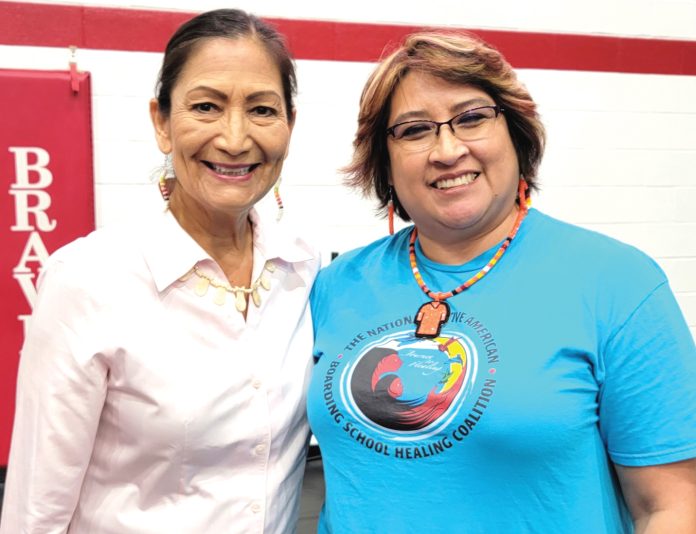
story by Van Mitchell, Staff Writer
Sonya Frazier, a nurse at the Wewoka Indian Health Center, said 2020 was a challenging and reflective year for Indigenous healthcare workers, their families, culture and Indigenous communities.
“It has been a reflection of our traumatic history causing deep seeded wounds to reopen,” said Frazier, who is of Chickasaw and Choctaw descent. “But like with any infected wound, it will need to be cleaned with love and healed from the inside out with the help of Indigenous nurses. As Indigenous nurses, we are unique in so many ways, not only individually but culturally and spiritually too. We must have a balance of understanding of the two worlds we live in every day. The western world and the Indigenous world.”
That reflection helped spur Frazier to organize and become the first President of the Oklahoma Indigenous Nurses Association (OINA) in 2021. (STORY CONTINUES BELOW)
“One of my goals was to get cultural awareness started, primarily focusing on Indigenous cultures in Oklahoma,” she said. “OINA was created during a time of much needed healing and to give a platform for Native Nurses to share, learn and heal together along with our Non-Native relatives. Indigenous knowledge and scientific knowledge are a restorative combination. To restore the old ways with the new ways.”
Frazier, R.N., B.S.N., said she reached out to various organizations for help, and said the Oklahoma Nurses Association responded. They wanted to see what her idea was on having a platform for Native American nurses to share and learn from each other and networking.
“It was to create a platform for healing because a lot of us Native nurses are going through healing ourselves as we identify the issues that come from the health disparities,” she said.
Frazier said the OINA has about 90 members state-wide, and is growing.
“We have a lot of non-Native nurses that want to be part of the Association, which we welcome because as we learn about each other’s histories and culture, we are going to provide better quality care for all people,” she said.
Frazier said they want to collect data on how many Native American nurses across the country.
Frazier said part of the OINA platform is to have monthly meetings, with bi-monthly speakers.
“We have a monthly Zoom meeting, and we usually have it the first Wednesday of the month, and every other month we have an Indigenous guest speaker,” she said. “It is all about networking and getting information out there. It is about educating and learning from each other.”
Frazier said OINA is also about continuing education and promoting the nursing profession in general.
“We encourage our Native nurses to continue with higher education,” she said. “We are reaching out to our Native youth to inspire them to go into nursing or the health profession in general.”
Frazier said the feedback from Oklahoma’s Native American tribes has been positive about interaction with OINA.
“It has been wonderful and it has been great,” she said. “The response has been great from the tribes who are ready to be part of this organization so that we can promote people to go into the nursing profession.”
Part of the traumatic history Frazier speaks about with Indigenous people, is the painful past of Indian boarding schools. Fraizer said both her parents and mother-in-law are boarding school survivors.
American Indian boarding schools, also known more recently as American Indian residential schools, were established in the United States from the mid-17th to the early 20th centuries with a primary objective of “civilizing” or assimilating Native American children and youth into Euro-American culture. In the process, these schools denigrated Native American culture and made children give up their languages and religion.
At the same time the schools provided a basic Western education. These boarding schools were first established by Christian missionaries of various denominations.
The missionaries were often approved by the federal government to start both missions and schools on reservations, especially in the lightly populated areas of the western United States.
In the late 19th and early 20th centuries especially, the government paid religious orders to provide basic education to Native American children on reservations, and later established its own schools on reservations.
The Bureau of Indian Affairs (BIA) also founded additional off-reservation boarding schools based on the assimilation model. These sometimes drew children from a variety of tribes. In addition, religious orders established off-reservation schools.
“The boarding schools were forced upon our people that caused a lot of the assimilation and mental health issues, alcoholism and disparities overall,” Frazier said. “Indigenous nurses have always been and still are the natural healers of their communities. To address the inequalities related to Indigenous communities and health will always begin with knowing and understanding the history (of boarding schools).”
For more information visit https://ona.nursingnetwork.com or on Facebook at Oklahoma Indigenous Nurses Association.











